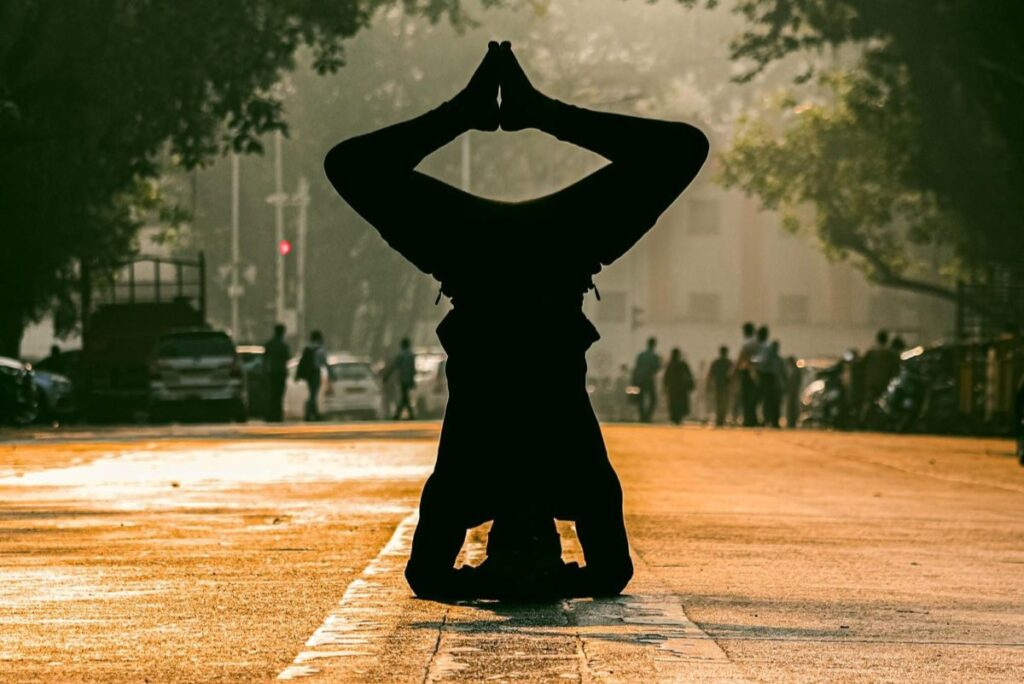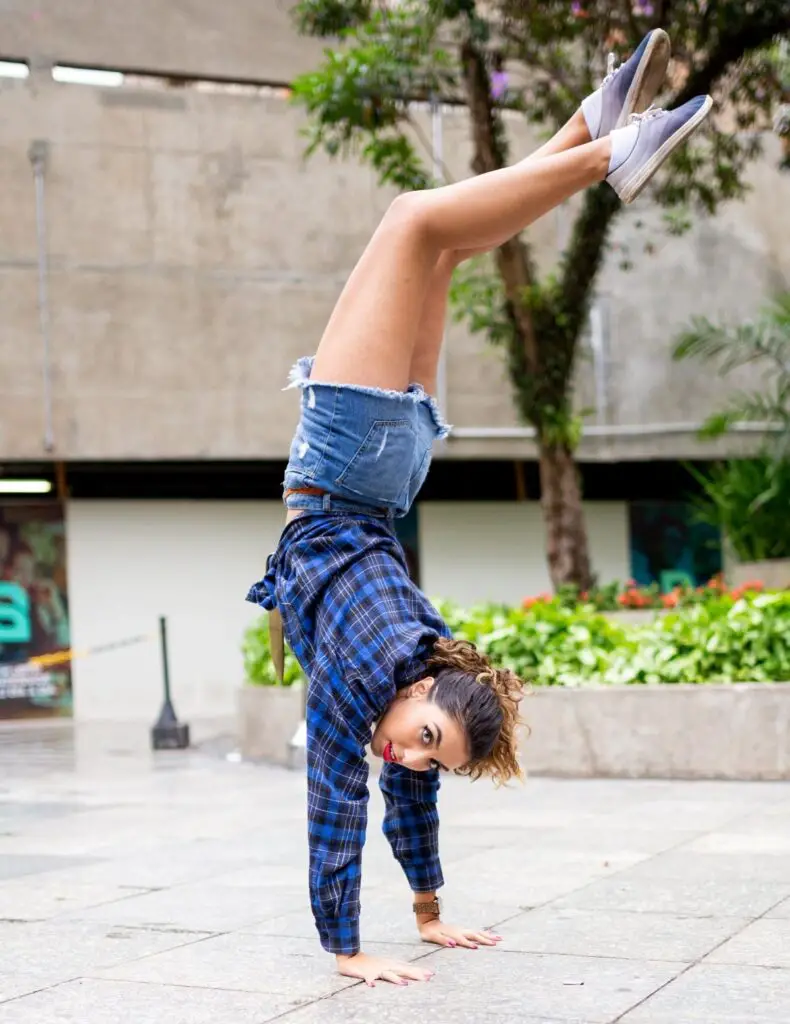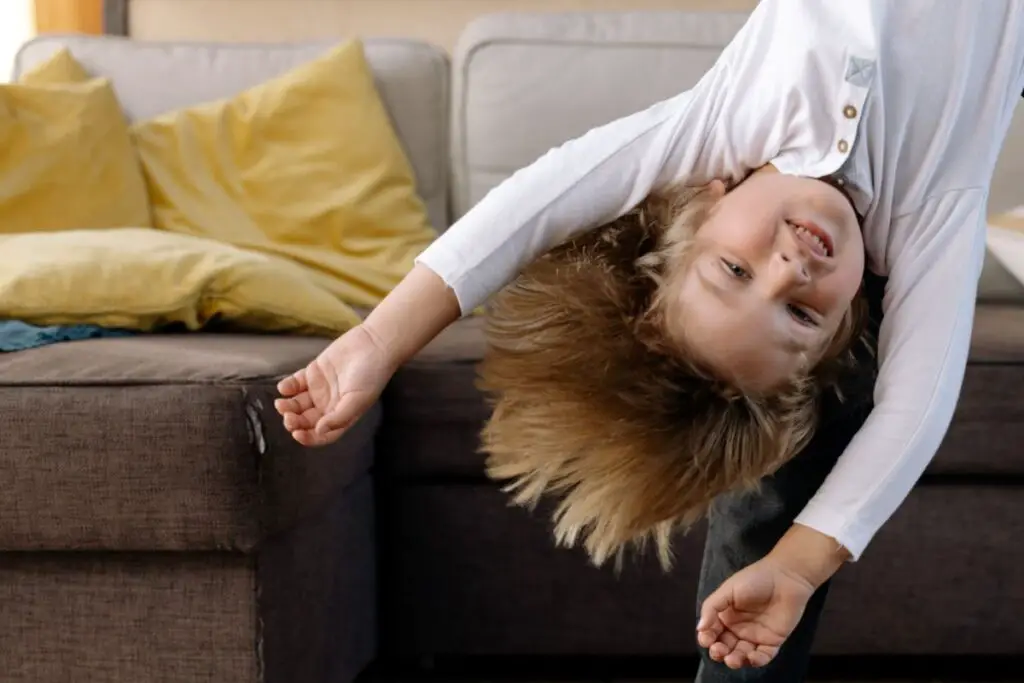Bottoms Up: Flipping Your World with Vestibular System Therapy
Stimming is a common behavior for children and adults alike on the autism spectrum disorder. Stimming, which is short for self-stimulation,” and refers to repetitive or atypical body movements like flapping hands, rocking, or spinning. Some autistics enjoy hanging upside down and going bottoms up, which is sometimes known as vestibular stimming.

Vestibular stimming is related to balance and can produce a sensation that calms an autistic child or adult who feels overwhelmed by their environment. While stimming techniques look different for every individual depending on personal needs and preferences, lesser discussed stims are hanging upside down or going bottoms up.
Inverted positions like handstands, headstands, using an inversion machine or rod at the gym, tumbling, dancing, hanging upside down from playground equipment, or going bottoms up can provide comforting pressure and sensory input for certain individuals.
The feeling of blood rushing to the head, compression on the body, and seeing the world from an alternate angle can satisfy sensory cravings in autistics. It’s one reason why many on the spectrum find the fast-paced rides of roller coasters that go upside down particularly exhilarating.
Additionally, the vestibular stimming from being upside down offers a centering, calming effect that counterbalances hypersensitivity. That’s considered one of the greatest benefits of hanging upside down.
Despite stereotypes, autistics of all ages may enjoy and sometimes even crave this style of self-soothing vestibular system therapy as one of the types of stimming. For neurodivergents who are prone to sensory overload and emotional dysregulation, having access to soothing inverted activities can make a positive difference.
Read more about autistic stimming behaviors and why we do it and how it’s important
Bottoms Up and Benefits of Hanging Upside Down: Why Inversion Calms
To understand the appeal of inversion, it helps to recognize core aspects of autistic perception. Many autistic individuals have heightened sensory sensitivity that makes ordinary stimuli painfully intense.
Tags in t-shirts, classroom or work chatter, and even direct eye contact can feel jarringly uncomfortable. At the same time, some autistic children and adults crave rich sensory experiences like deep pressure, spinning, or extreme textures.
Going bottoms up, twirling, or hanging upside down allows individuals on the spectrum to safely meet sensory needs in a regulated way.
The compression of being inverted has a containing effect as part of vestibular system therapy, similar to therapies like weighted blankets that apply deep pressure. But unlike with a blanket, individuals are able to actively control the input with inversion.
The vestibular stimming feeling realigns the senses, almost like a reset button after overwhelming stimulation. Staring at the world from a brand new vantage point also captures attention and soothes restlessness. For individuals struggling with emotional and sensory regulation, having an accessible outlet such as vestibular system therapy makes them feel secure can improve self-confidence.
Read more about 10 proven techniques for managing autism and sensory issues
Benefits of Going Bottoms Up: Developing Strength and Body Awareness

The feeling of mastering a new position through core engagement builds physical confidence. It also naturally motivates kids to practice essential motor skills, from crossing the midline to bilateral coordination.
While individuals on the spectrum often face challenges with picking up movement foundations, tolerating touch, or conceptualizing body boundaries, gentle inverting play allows them to expand comfort zones.
Bottoms up poses in children are easier: hanging upside down in the playground or doing inverted walks in physical education classes or in therapy. But, less obvious practices are enjoyed in older individuals as well.
While teens and adults may not choose hanging upside down in a tree, they may enjoy handstand and tumbling classes, yoga poses and stretches, and gym-related core equipment. Dancers and gymnasts also experience many moves that involve the inverted position.
Starting with poses where individuals control positioning mitigates fears of falling that might otherwise trigger sensory defensiveness. As individuals gain assurance holding inverted postures, it empowers them to tentatively explore movement.
This process gradually strengthens developmental building blocks missed early on due to sensory sensitivity, from transverse abdominals that stabilize to signals about body in space.
Read more about the surprising link between autism traits and physical fitness
Creating a Safe Sensory Space with Hanging Upside Down
For individuals looking to try inversion therapy, which is also called vestibular rehabilitation therapy, creating a safe sensory space remains vital, as tolerance varies widely based on developmental age and abilities. Parents can start by letting a child hang supported, either from bars or while held in adult arms.
This introduces a feeling of blood shift and compression without demands to hold weight. Working up slowly to poses like downward dog against the wall allows individuals to back out easily if uncomfortable. Success should focus on enjoyment, not strict imitation of poses.
Exploring vestibular system therapy options like slant boards, inversion swings, yoga walls and trapeze tables also offer more independent mobility. Thanks to adjustable angles and postural support, these tools provide kids maximal control over input and positioning relative to abilities.
Customizing experiences to match small developmental steps is key—there is no standard timeline. Meeting persons with neurodiversity where they’re at and adjusting challenges to push the edge while preventing dysregulation should guide the process.
Read more about 5 fun physical activities that promote better autism health
Vestibular System Therapy: Staying Mindful While Inverting
Even extremely helpful stims have the potential for harm if done excessively by autistics unaware of danger or limitations. Joint hyperextension and restricted circulation are prime risks while inverted. Mindfulness matters enormously when trying vestibular rehabilitation therapy.
Along with adult supervision, kids must learn to listen and respond to physiological cues from their own bodies to invert safely. Adults should also have a trainer on hand to make sure they are also inverting safely.
Of course, nausea, dizziness, fatigue or pain signals that mean it’s time for a break. Through consistent practice within personalized limits, individuals can gain life-long sensory sensitivity improvements.
5 Vestibular System Therapy Inversion Tips and Ideas
Trying inverted play may seem intimidating if you’re uncertain where to begin or how to prevent fatigue and ensure safety. Yet with a few simple guidelines, individuals of all ages can explore being upside down while having fun and expanding developmental horizons too!
Start Easy
Very first attempts should set autistics up for success, not scare them away from inverting altogether. That means leaving gravity mostly out at initial stages. Kids and adults alike should first lie on their stomach over an exercise/yoga ball so their legs rise with support.
Have someone gently roll the ball side-to-side so their feet rock overhead, getting used to blood redistribution. For young children if willing, adults pick them up by both hands and feet for brief moments so muscles learn the novel sensation of dangling and stretching upward without strain.
Build Slowly
Once individuals enjoy fundamental sensations of being upside down, gradually challenge endurance so bodies adapt without injury. After spending periods of time inverted, then progress to wall walks and planks over weeks or months as individuals indicate readiness through eagerness to advance.
Always go at the person’s pace and choose ease over goals when trying vestibular system therapy. Let boredom or frustration, not arbitrary metrics, determine when to try more taxing postures. Reinforce effort, not just accomplishment.
Incorporate Fun Motivation
The element that makes skill-building stick is intrinsic motivation—help them love inverting rather than dread imposed activities. For children, turn music on and let them dance or tumble freely with occasional upside down play. Bring inversion tools like swings and trapeze bars to playground visits so they link the experience with joy.
Family activities can include fun like making like baby bats together by having the whole family hang from knees over couches amid laughter and connection.
Whether the autistic is a child or the teen or parent, there are exercises and activities that can be done together for the enjoyment of everyone.
Add Variety and Stimming Supports
Switch things up with plenty of novel accessories and objects to rejuvenate interest like textured mats, acrobat ribbons, balance beam blocks, hula hoops and more. All ages might enjoy obstacle courses or even Olympic-style challenges.
With younger aged children, provide additional calming fidgets such as chewy necklaces, plush toys and resistance bands. Building multisensory input lets autistics control stimulation, preventing feelings of being overwhelmed—a precursor to exhaustion and meltdowns.
Brief structured inversions followed by related sensory play makes for ideal progression.
Encourage Spontaneity and Choice
Structured plans occasionally important, yet leave abundant space for independence. Individuals should be able to spontaneously find their way into comfortable positions—or choose not to go upside down despite encouragement.
Honoring playful intuition and signals of disinterest keeps inversion rewarding on sensory and emotional levels.
Reinforce kids hanging just a few seconds if they lead initiation, instead of insisting on specific techniques. Upside down play works best when children own process.
For adults choosing variations of vestibular system therapy, setting goals and choosing to be disciplined and self-motivated can go a long way in achieving the benefits of hanging upside down in whatever form that might take.
Types of Stimming and Why It Helps Achieve Balance and Calmness

With these simple principles in place from the outset, autistics not only gain developmental advantages through inversion training, but they also see themselves as powerful bodies and minds entitled to self-care and dignity.
That lesson lasts far beyond any specific calming strategy or physical skill mastered!
Going or hanging upside or bottoms up under proper conditions can offer autistic individuals a tool for self-regulation they can always carry within themselves. While popularized interventions often focus on disguising or eliminating stims, embracing activities like inversion therapy empower individuals by understanding and fulfilling sensory needs.
Building confidence through movement skills is simply an added benefit!
Read more about mastering your mind and discovering the secrets of stoicism philosophy
Living Your Best Autistic Life With Therapy and Support
Eliminating or reducing unhealthy coping mechanisms and replacing them with healthier alternatives such as vestibular rehabilitation therapy takes time, self-reflection, and a lot of trial and error. But the journey is worth it.
Living authentically, embracing life’s ups and downs, and nurturing mental health leads to a fulfilling life. With the right support and strategies, autistic individuals can better manage challenges, understand themselves deeply, and play to their unique strengths. The road may be bumpy at times, but it ultimately leads to a beautiful destination.
Read more about self-identity and why it’s the ultimate guide for finding your true self
Other Common Autistic Behaviors
There are many behaviors associated with having autism. Keep in mind that everyone presents differently, which is why it is caused a spectrum disorder. However, there are common autism behaviors. Learn more about them.
- Autism and Eye Rolling: Why It’s Odd, But Perfectly Okay
- Spotlight on the Spectrum: Understanding the 3 Levels of Autism
- Eye Contact Avoidance: 8 Best Ways to See Eye to Eye
- 10 Proven Techniques for Managing Autism and Sensory Issues
- Understanding Neurodiversity: Uprising of the Neurodivergent
- 5 Ingenious Ways for Creating Boundaries in a Relationship
- Autism and ADHD: Making Sense of the Overlap
- Autism Masking & Code Switching: How to Redefine Acceptance
- Autistic Stimming Behaviors: Why We Do and How It’s Important
- OCD and Autism: Could You Have One Condition or Both?
- Autism in Sports: Hyper-Focus Can Be A Commanding Competitive Advantage
 Family activities can include fun like making like baby bats together by having the whole family hang from knees over couches amid laughter and connection.
Family activities can include fun like making like baby bats together by having the whole family hang from knees over couches amid laughter and connection.